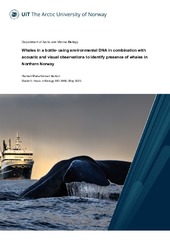Whales in a bottle- using environmental DNA in combination with acoustic and visual observations to identify presence of whales in Northern Norway
Author
Benton, Hannah Maria IversenAbstract
Whales have several important ecological functions as top predators in marine ecosystems and may also serve as sentinels of anthropogenic activities that drive ecosystem shifts. It is therefore important to have efficient methods to monitor the spatiotemporal presence of different whale species in the vast ocean realm. Traditionally, visual observations from research vessels have been the method of choice, although this method has several limitations, including weather and light conditions, and personal skills of the observer. More recently, acoustic arrays or towed cables have also been used to identify the presence of whales, but these are limited to specific frequencies and identifiable species-specific sounds for speciation. In recent years, environmental DNA (eDNA) techniques have been increasingly used to provide information on the biodiversity of a given area with information extracted from filtered sea water. Sampling eDNA could potentially serve to aid in monitoring the spatiotemporal presence of whales, while also contributing additional trophic and ecosystem information. Therefore, the main goal of this study was to conduct horizontal eDNA sampling transects from surface waters to compare whale detections with visual observations and hydroacoustic recordings of whales. In addition to examining the spatiotemporal structuring of fish communities that could possibly serve as whale food resources through vertical eDNA sampling of whale hotspots and horizontal eDNA transect sampling. This was done in March 2024 in four close-proximity areas off the coast of Northern Norway (ranging from ~69-70° N) that are known to be highly productive and known to harbor seasonal aggregations of several whale species, especially sperm whales (Physeter macrocephalus). The results showed that the three detection methods generally did not align directly with each other. While eDNA was able to capture the highest amount of diversity, hydroacoustics had the highest amount of overall whale detections. Visual observations detected whales more frequently than eDNA and a higher number of whale species than hydroacoustics. The results also indicated that eDNA might be able to detect whales from a greater distance than some previous studies. Further research and developments are needed to efficiently use eDNA analysis as a whale detection method, but it has great potential to be used in combination with other methods. For the fish communities, eDNA sampling identified several species of demersal and pelagic fish in the areas, with the most relative abundant being Clupea sp. and Mallotus villosus, indicating that these may be keystone species in the area during the time of year sampling took place, when they spawn on the continental shelf, potentially attracting whales. This further illustrates how eDNA can add new layers of information that can support the traditional whale abundance estimate methods.
Publisher
UiT The Arctic University of NorwayMetadata
Show full item recordCollections
Copyright 2025 The Author(s)


 English
English norsk
norsk
